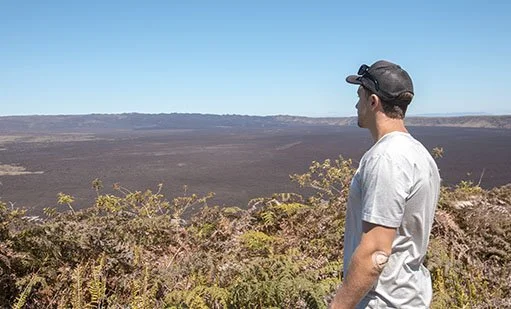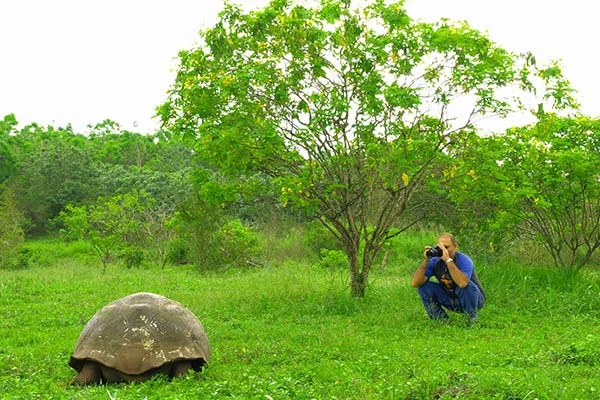
Galapagos Human History
Galapagos in History – Human Presence
Thus we can look back at nearly five centuries of human contact with the Galapagos and say that, without a doubt, the most important event in the human history of the Galapagos was Darwin’s visit in 1835. Even without Darwin, the tale of human contact with the Galapagos is a fascinating one, and the Enchanted Islands, as the early mariners called them, have meant many things to many people from many lands around the globe.
An abandoned Irishman is considered the first settler in the archipelago
19th Century – The First Inhabitant: Patrick Watkins
Curious about the human history of the Galapagos? At the beginning of the 19th century, an Irish sailor was abandoned on Charles Island (Floreana Island), his name was Patrick Watkins and he is considered to be the first inhabitant of the Galapagos Islands.
He cultivated vegetables, which he traded to the whalers for rum and several years later managed to obtain a boat and recruit a few men which he took to sea in hopes of returning to dry land. Strangely he arrived at Guayaquil alone and then went to Patia where he convinced a mulatto woman to accompany him back to the island. He spent the rest of his days in prison after being arrested while trying to steal a ship.
Human History of the Galapagos Islands : Overview
- 1485 – The first visitors were sailors of the Chimu culture from northern Peru during the rule of the great Inca, Tupac Yupanqui.
- 1535 – The official discovery of Galapagos, on March 10th, by Fray Tomas de Berlanga, a Spanish Bishop, aboard a ship pushed off course by ocean currents while sailing from Panama to Peru.
- 1570 – The Galapagos Islands appear for the first time on a world map. They are called “Insulae de los Galopegos.’ For a complete chart of the islands visit our Galapagos Map Center
- 1593 -1710 – Use of the Galapagos by pirates as refuge and supply base for water and meat (particularly the giant tortoises). Introduction of goats and dogs to the islands.
- 1793 -1870 – Period of whale exploitation in the Islands threatening populations of tortoises, fur seals and whales.
- 1793 – Erection of the post office barrel on Floreana to facilitate delivery to the United States and Europe.
- 1800 -1900 – The exploitation of fur seals by North Americans and Europeans almost causing Galapagos Fur seal
extinction. - 1832 – Ecuador officially claims Galapagos calling it “Archipelago del Ecuador.” Islands are given their Spanish names.
- 1835 – Visit of the H.M.S. Beagle to Galapagos for five weeks, from September 15 to October 20. During this period, Charles Darwin visited San Cristobal, Santiago, Floreana and Isabela Islands. The Captain, Robert Fitzroy, drew up accurate navigation charts.
- 1841 – U.S. writer Herman Melville visits Galapagos. He later wrote an articulate account of his experience in “Las Encantadas.”
- 1859 – Publication of Charles Darwin’s The Origin of Species which brought recognition to Galapagos as a natural laboratory for evolution.
- 1892 – Galapagos is officially named “Archipelago de Colon” in honor of Christopher Colombus’s discovery of America 400 years earlier.
- 1905 – 1906 – Scientists from the California Academy of Science make extensive collections and studies of the islands.
- 1923 – Visit by American William Beebe, whose book Galapagos World’s End, gave worldwide fame to the Islands.
- 1926 – Group of Norwegians arrive in Galapagos. Some still remain today on Santa Cruz island farming in the highlands.
- 1934 – First legislation to protect Galapagos fauna is passed. Mysterious events surround the disappearance of the Baroness Van Wagner and a companion, and the deaths of others on Floreana. This same year the first known tourists arrived on the islands on board the Stella Polaris ship, this was the beginning of what we know as Galapagos expedition cruising, today, travelers can also stay at island hotels and take Island hopping tours
- 1941- 1948 – Construction and occupation of an air base on Baltra by the U.S. and the extinction of land iguanas on that island.
- 1959 – On July 4th, the government declares all areas of Galapagos as National Park except for the colonized areas. The Charles Darwin Foundation is founded in Brussels on July 23rd. Its first President is Victor Von Staelen.
- 1964 – The Darwin Station is inaugurated in the presence of many national and international authorities.
- 1968 – Administration of the Galapagos National Park Service begins.
- 1969 – Large-scale tourism begins in Galapagos with the arrival of the LINA-A, a ship carrying 58 passengers.
- 1971 – Lonesome George is found on Pinta Island, the last of his breed.
- 1972 – Japanese fishing ships capture hundreds of sea turtles.
- 1974 – The first master plan for the protection and management of the Galapagos National Park is published.
- 1978 – The Islands are declared a World Heritage site by UNESCO underlining its universal value for mankind. o
- 1986 – The Galapagos Marine Resources Reserve is signed into law by President Leon Febres Cordero to protect the waters 15 miles offshore.
- 1992 – A new revised, long-term master plan for the development and management of the CDRS, which will provide guidelines for the Station’s programs and gradual growth to its full potential.
- 1994 – A fire in Isabela Island causes damage to 20,000 square miles near Volcano Sierra Negro. 70-80 tortoises are slaughtered by fisherman in protest of the governments indecision to lift a ban on commercialized fishing.
- 1995 – Isabela threatened by introduced plants and animals and overgrazing by goats.
- 1998 - Under new Special Law for Galapagos, the Marine sanctuary was expanded to encompass more than 54000 Sq. Miles (140,000 Sq.km) turning it into the 2nd largest oceanic reserve on he planet.
- 2001 - The Galapagos marine reserve is added to the UNESCO marine sanctuary list



